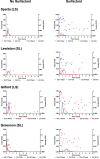Detection, fate and transport of the biohazardous agent Toxoplasma gondii in soil water systems: Influence of soil physicochemical properties, water chemistry and surfactant
- PMID: 37740249
- PMCID: PMC10667666
- DOI: 10.1111/1758-2229.13204
Detection, fate and transport of the biohazardous agent Toxoplasma gondii in soil water systems: Influence of soil physicochemical properties, water chemistry and surfactant
Abstract
A series of laboratory experiments were conducted to study the fate and transport of Toxoplasma gondii oocysts in soils as a function of soil physicochemical properties and soil water chemistry properties. Soil columns were homogeneously packed with loamy sand soils (Lewiston and Greenson series) and sandy loam soils (Sparta and Gilford series), and subject to hydrologic conditions characterized by the absence and presence of an anionic surfactant-Aerosol 22 in the artificial rainfall. Quantitative polymerase chain reaction (qPCR) was utilized for the detection and enumeration of oocysts in soil leachates to evaluate their breakthrough and in soil matrices to examine their spatial distribution. Differences in the rate and extent of transport of oocysts were observed as a function of physical and chemical parameters tested. The breakthrough of oocysts was observed for all the soils irrespective of the presence of surfactant. However, in the absence of surfactant, the predominant fate of oocysts in soils subject to simulated rainfall was their retention in the soil profile. The presence of surfactant induced a change in the fate of oocysts in these soils exposed to rainfall simulation as the predominant fate of oocysts was found to be in the soil leachates.
© 2023 The Authors. Environmental Microbiology Reports published by Applied Microbiology International and John Wiley & Sons Ltd. This article has been contributed to by U.S. Government employees and their work is in the public domain in the USA.
Conflict of interest statement
The authors declare that they have no known competing financial interests or personal relationships that could have appeared to influence the work reported in this paper.
Figures


References
-
- Abudalo, R.A. , Ryan, J.N. , Harvey, R.W. , Metge, D.W. & Landkamer, L. (2010) Influence of organic matter on the transport of Cryptosporidium parvum oocysts in a ferric oxyhydroxide‐coated quartz sand saturated porous medium. Water Research, 44(4), 1104–1113. - PubMed
-
- Afonso, E. , Lemoine, M. , Poulle, M.L. , Ravat, M.C. , Romand, S. , Thulliez, P. et al. (2008) Spatial distribution of soil contamination by Toxoplasma gondii in relation to cat defecation behaviour in an urban area. International Journal for Parasitology, 38(8–9), 1017–1023. - PubMed
-
- Al‐Jayyousi, O.R. (2003) Greywater reuse: towards sustainable water management. Desalination, 156(1–3), 181–192.
Publication types
MeSH terms
Substances
Grants and funding
LinkOut - more resources
Full Text Sources

